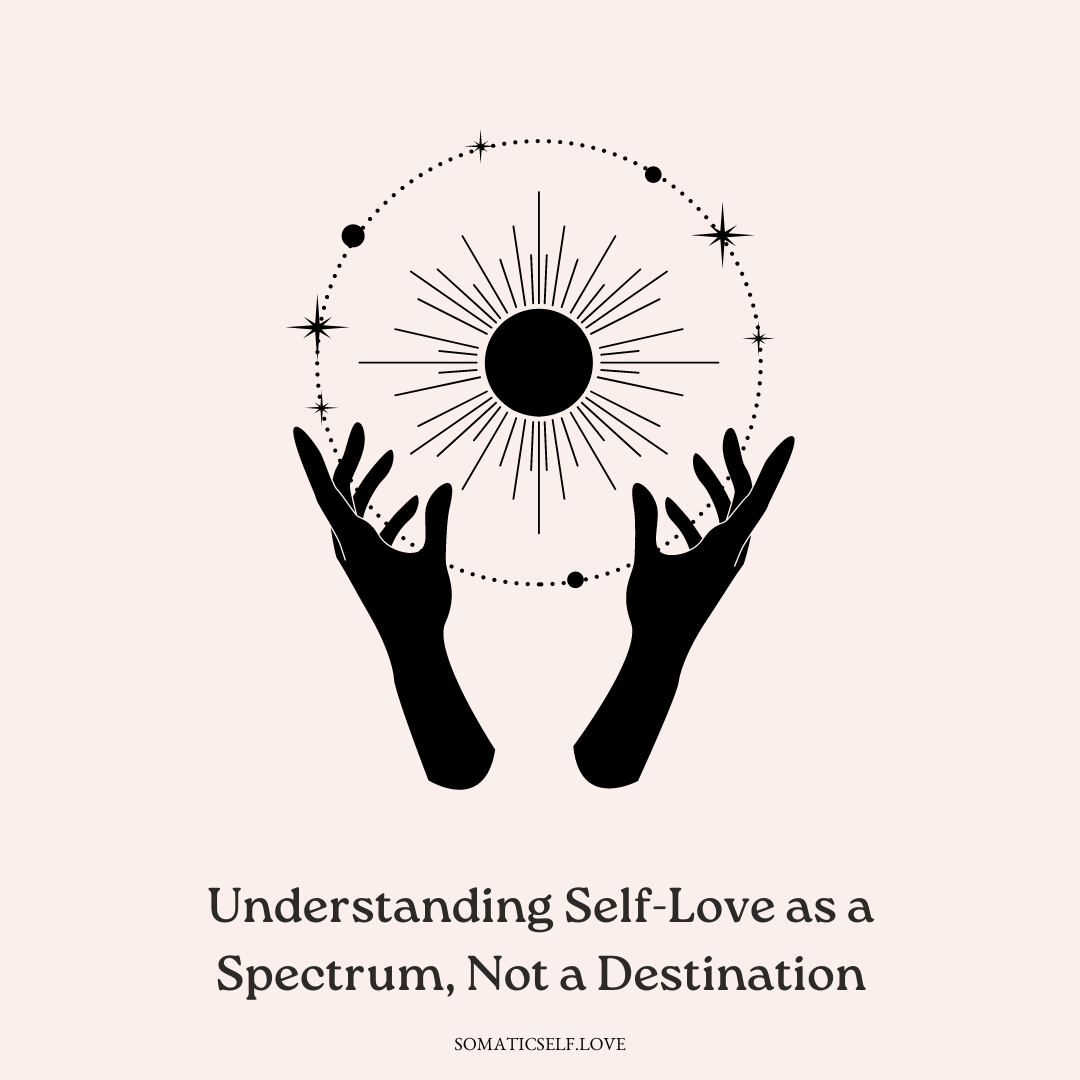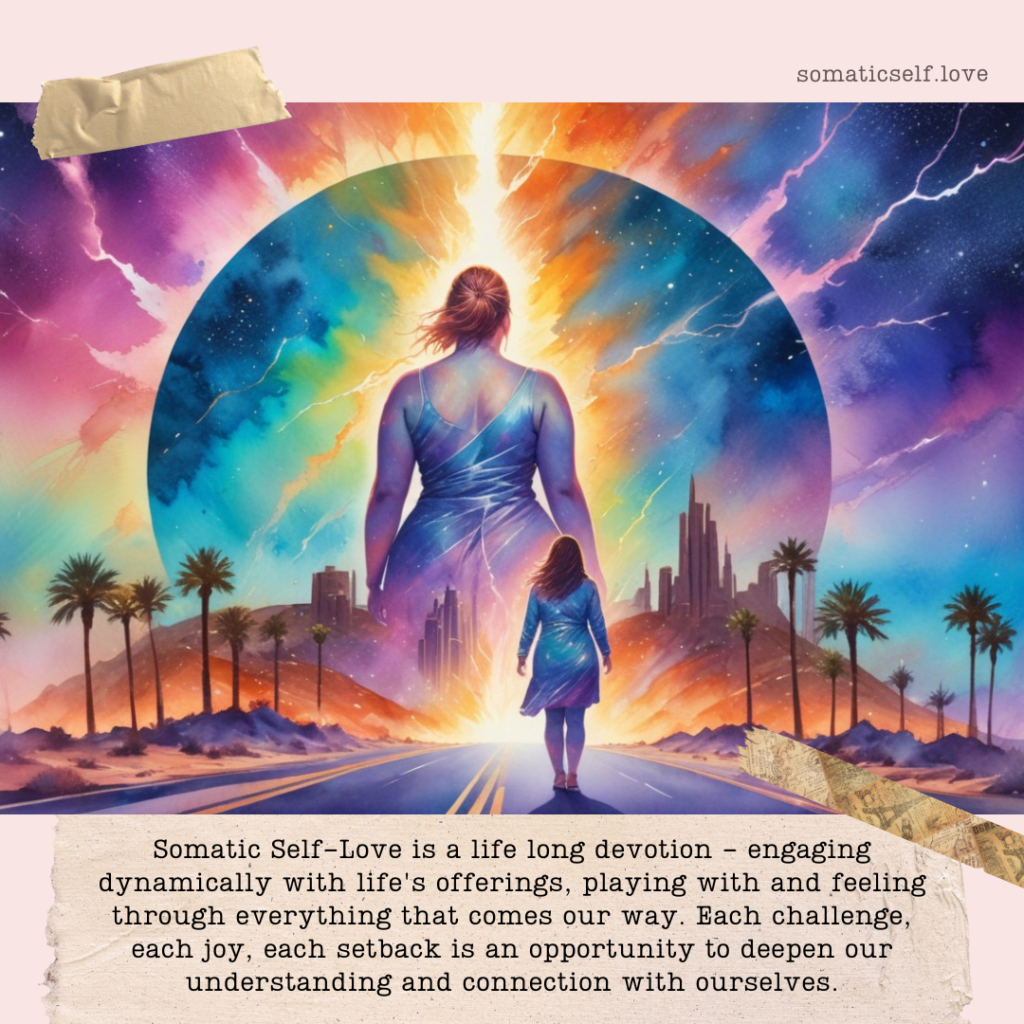Understanding Self-Love as a Spectrum, Not a Destination

Have you ever noticed how eager we are to categorize and measure ourselves? Success is often measured in tangible terms: the size of a paycheck, the brand of a car, or the number of followers on social media.
Outside of this cultural addiction to striving for measurable results, somatic self-love offers a way that is more nuanced and liminal, resisting the simplifications of binary definitions. Unlike the black-and-white ways we’re often taught to view the world, self-love isn’t a simple, binary state. It isn’t something you either have in full measure or lack entirely. Rather than fitting neatly into the binary categories we’re accustomed to, self-love flows across a spectrum, challenging us to engage in a continuous dance of self-discovery and acceptance that defies simple measurement.
Beyond Binary Thinking
Part of the beauty of somatic self-love lies in its ability to challenge the binary thinking that dominates much of our thinking—good or bad, right or wrong, love or hate. Thinking of self-love as a simple yes/no state can be reductive and misleading. It wrongly assigns moral values to a natural, human experience. Feeling good about yourself doesn’t make you a saint, just as struggling with self-love doesn’t make you a sinner.
A study by Carol Dweck and colleagues, published in Personality and Social Psychology Review, emphasizes the benefits of embracing a growth mindset over a fixed mindset. This research indicates that when we view personal qualities as malleable rather than fixed, we are better at handling challenges and are more open to new experiences.
By moving from binary thinking to a growth-oriented approach, we better adapt to life’s complexities. Our ever-evolving experiences nudge us back and forth along this spectrum of self-love, each moment offering a new chance to explore and renegotiate how we relate to ourselves. There’s no final destination or perfect state to achieve—it’s all about the movements.
A Lifelong Devotion
If we think of somatic self-love as something to nurture as things evolve and change, the practice becomes a lifelong devotion. It’s about engaging dynamically with life’s offerings, playing with, dancing with, and feeling through everything that comes our way. Each challenge, each joy, each setback is an opportunity to deepen our understanding and connection with ourselves.
Research in the field of psychology reinforces the benefits of such an approach. A study by Dr. Kristin Neff and her colleagues, published in the Journal of Research in Personality, demonstrates that self-compassion, a key component of somatic self-love, is not static but grows and strengthens through life’s adversities.

This study found that individuals who actively practice self-compassion navigate stress and setbacks with greater ease, experiencing less anxiety and depression in the process. This evidence supports the idea that somatic self-love, cultivated over time, not only enhances our emotional resilience but also enriches our capacity to experience joy and satisfaction in life’s continuously unfolding journey.
This is a Practice, Not a Destination
This isn’t about chasing a fleeting moment of ‘perfection,’ which, let’s be honest, doesn’t really exist. Our bodies and emotions are always in flux, and recognizing this can shift our focus from striving for an impossible ideal to embracing a more compassionate, authentic journey toward self-understanding.
Recent neuroscientific research supports this view by demonstrating that consistent practices of mindfulness and self-compassion can actually rewire our nervous systems, leading to lasting changes in the brain associated with increased emotional resilience and well-being.
A study published in the journal Frontiers in Human Neuroscience found that participants who engaged in mindfulness-based stress reduction (MBSR) showed significant structural changes in areas of the brain related to attention, emotion regulation, and self-awareness.
These findings suggest that regular engagement in practices that promote awareness and acceptance could fundamentally alter the way our brains process emotions and stress, highlighting the transformative power of viewing self-love as a continuous practice rather than an achievement.
From Judgment to Curiosity
Somatic self-love practice encourages us to move from judgment to curiosity, from rejection to acceptance, and from stagnation to ongoing exploration. As we learn to navigate this spectrum, we open ourselves up to a richer, more compassionate engagement with life. This isn’t just about understanding ourselves better but also enriching how we interact with the world around us.
Recent research supports the transformative power of curiosity in fostering personal growth and enhancing social interactions. A study by Todd Kashdan and colleagues, published in the Journal of Personality and Social Psychology, found that curiosity leads to an increase in meaningful life events, which in turn fosters personal growth and increased feelings of well-being.
This study suggests that curiosity not only enhances our understanding of ourselves but also improves our social relationships by promoting a greater engagement with others and a deeper appreciation of diverse perspectives.
By replacing judgment with curiosity, we not only enhance our own well-being but also contribute to a more understanding and compassionate world. This shift from a fixed to a growth-oriented perspective invites continuous learning and adaptation, key components of a fulfilling and resilient life.
Through this lens, we become better listeners, more empathetic friends, and more supportive companions. We learn to appreciate the full complexity of human experience, embracing the nuances that make life rich and rewarding.
A Call to Embrace Life Fully
So, what does all this mean for us in practical terms? It means giving ourselves the grace to be in constant motion, to accept that we’re all works in progress. By acknowledging and embracing the non-binary nature of somatic self-love, we allow ourselves to experience the full spectrum of life with all its ups and downs.
This journey of somatic self-love isn’t just about feeling better about ourselves; it’s about fundamentally transforming our approach to life and relationships. It’s about living fully, loving deeply, and moving confidently in the world with a profound sense of our own worth.
Somatic Self-Love Ritual: From Judgement to Curiosity
This ritual is designed to help you cultivate somatic self-love by moving from judgment to curiosity, from rejection to acceptance, and from stagnation to ongoing exploration. By integrating mindfulness, self-compassion, and curiosity, this practice aims to foster a growth-oriented mindset and enhance emotional resilience.
Materials Needed
- A quiet, comfortable space
- A journal and pen
- A yoga mat or comfortable seating
- Soft, calming music (optional)
- Candles
Steps
- Preparation
- Find a Quiet Space: Choose a comfortable and quiet area where you won’t be disturbed.
- Set the Mood: Place candles around your space and light them to create a soothing atmosphere. Play soft, calming music if desired. Light a candle or use essential oils to enhance the environment.
- Invocation (2 minutes)
- Opening Words: Stand or sit in your space, close your eyes, and take a few deep breaths. When you feel ready, speak the following invocation aloud:
- “I invite peace and self-love into this space. May this ritual be a sanctuary for my body and spirit. I honor my journey and embrace my growth. So it is.”
- Opening Words: Stand or sit in your space, close your eyes, and take a few deep breaths. When you feel ready, speak the following invocation aloud:
- Grounding and Centering (5 minutes)
- Sit Comfortably: Sit cross-legged on a yoga mat or in a chair with your feet flat on the ground.
- Deep Breathing: Close your eyes and take several deep breaths. Inhale deeply through your nose, hold for a moment, and exhale slowly through your mouth. Repeat this process for a few minutes to center yourself.
- Body Scan (10 minutes)
- Mindful Observation: Starting from the top of your head, slowly move your attention down your body. Notice any areas of tension, discomfort, or ease.
- Non-Judgmental Awareness: As you scan each part of your body, observe your sensations without judgment. Simply notice what you feel and where you feel it.
- Somatic Sounding (10 minutes)
- Hands Over Heart: Place your hands over your heart and take a few deep breaths to center yourself.
- Feel Into Sensations: Tune into the sensations in your body. Notice any areas of tension, warmth, discomfort, or ease.
- Give Sounds to Sensations: Allow yourself to make sounds that resonate with what you are feeling. These could be hums, sighs, moans, or any other vocal expressions that feel right. Let the sounds flow naturally and intuitively, providing a somatic release and expression.
- Curiosity Journaling (10 minutes)
- Reflective Questions: Open your journal and write responses to the following prompts:
- “What areas of my life am I judging harshly?”
- “How can I approach these areas with curiosity instead of judgment?”
- “What new experiences or perspectives can I explore to foster growth?”
- Growth Mindset: Reflect on how adopting a growth mindset can help you navigate challenges and new experiences with openness and resilience.
- Reflective Questions: Open your journal and write responses to the following prompts:
- Mindful Movement (10 minutes)
- Gentle Stretching: Engage in gentle stretching exercises or yoga poses that feel good to your body. Focus on the sensations of movement and breath.
- Dance or Free Movement: If you feel comfortable, allow yourself to move freely to the music. Let your body express itself without judgment or restriction.
- Closing Reflection (5 minutes)
- Integration: Sit quietly and reflect on your experience. Notice any shifts in your body, mind, or emotions.
- Gratitude: End your ritual with a moment of gratitude. Thank yourself for taking this time to nurture your somatic self-love.
- Closing the Space
- Extinguish the Candles: As you blow out each candle, silently acknowledge the light and warmth it brought to your ritual. Close your practice with a final deep breath, sealing your intention of self-love and inner harmony.
Engage in this somatic self-love ritual regularly to cultivate a deeper connection with yourself. Remember, this practice is not about achieving perfection but about embracing the continuous journey of self-discovery and acceptance. Each time you engage in this ritual, you strengthen your emotional resilience and enhance your capacity for joy and well-being.
Sources
- Carol Dweck’s Research on Growth Mindset
- Study: “Mindsets: The New Psychology of Success”
- Journal: Personality and Social Psychology Review
- Link: Mindsets: The New Psychology of Success
- Dr. Kristin Neff’s Research on Self-Compassion
- Study: “Self-Compassion and Adaptive Psychological Functioning”
- Journal: Journal of Research in Personality
- Link: Self-Compassion and Adaptive Psychological Functioning
- Mindfulness-Based Stress Reduction (MBSR) and Brain Changes
- Study: “Mindfulness practice leads to increases in regional brain gray matter density”
- Journal: Frontiers in Human Neuroscience
- Link: Mindfulness practice leads to increases in regional brain gray matter density
- Todd Kashdan’s Research on Curiosity and Well-Being
- Study: “The Curiosity and Exploration Inventory-II: Development, Factor Structure, and Psychometrics”
- Journal: Journal of Personality and Social Psychology
- Link: The Curiosity and Exploration Inventory-II